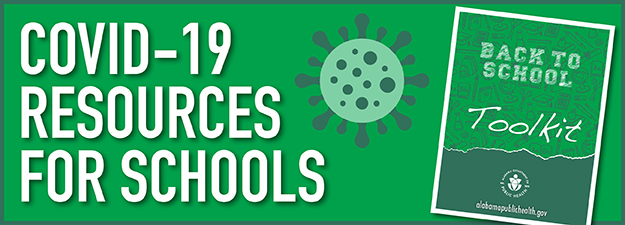MONTGOMERY, Ala. – The Alabama Department of Public Health (ADPH) recently released its “Back to School Toolkit,” a guidebook for school systems statewide to use as they return to the classroom this month amid the ongoing COVID-19 pandemic.
In its introduction, the Toolkit states, “The Roadmap for Reopening K-12 Schools addresses the need for schools, local health departments, and healthcare providers to work together to support the goal of all students returning to school safely during the COVID-19 pandemic. In order to ensure that our county health departments are providing consistent and accurate information to local schools, the Alabama Department of Public Health developed this toolkit of best practices recommended by ADPH and the CDC. This toolkit is a living document – new information is being updated daily on the COVID-19 virus. The toolkit will be used by ADPH staff to inform and support schools in their efforts to reduce COVID-19 transmission and will also be shared with school systems as a resource for local decision-making.”
The Toolkit contains information about quarantine and isolation, contact tracing procedures, ways to report positive or suspected COVID-19 cases to the ADPH and guidelines for counties based on their risk category. Additionally, there is an appendix of considerations for K-12 schools’ readiness plans and another appendix of printable resources which can be handed out to students and families.
The document outlines key principles that schools should consider when reopening:
- Social distancing – spacing student desks 6 feet apart and minimizing the time students spend in closer proximity (such as standing in lines)
- Face coverings – recommending that all students and staff wear cloth face coverings that cover the nose and mouth (especially when social distancing is not feasible) and reinforcing the importance of these coverings
- Face shields – not recommended as a substitute for cloth face masks, but should wrap around the sides of the head and extend below the chin if worn without one
- Seating charts – using permanent seating charts in classrooms and on buses to identify which students were in close contact with a student who tests positive for COVID-19
- Student movement within school – avoid having large groups of students moving around at once (if possible, have teachers move between classrooms instead of students) and eliminate activities that combine large groups of students or staff (combining classes or grade levels, school assemblies, field trips, etc.)
- Meals – minimize the number of students in the cafeteria at one time, encourage students to bring their own meals from home if possible and use prepackaged or individually plated food with disposable utensils
- Hand washing and hand sanitizer – remind students to wash hands with soap and water for at least 20 seconds before eating and after coughing, sneezing or using the restroom. If soap and water are not readily available, use hand sanitizer that is at least 60% alcohol. (Note: 60% alcohol refers to the solution as a whole, not the kind of alcohol used. If you make your own sanitizer, this means a mixture of two parts 99% rubbing alcohol to one part gel)
- Cleaning and disinfecting – frequently touched surfaces in buildings and on buses should be disinfected at least daily or between uses as much as possible, and use of shared objects should be limited
If a student or staff member tests positive or becomes ill with COVID-like symptoms, schools are recommended to implement the following 5-step procedure:
- Positive or suspected student/staff will be isolated from others in a pre-designated COVID-19 room and sent home.
- Identify close contacts to the staff or student. The close contacts will be isolated and sent home until a COVID-19 or other diagnosis is confirmed
- The school nurse or principal will report the positive or suspected case to ADPH using the online COVID-19 Report Card found at www.alabamapublichealth.gov/covid19/healthcare.html
- The school will use their existing school process to notify parents/guardians that an exposure has occurred. Confidentiality and privacy must be maintained.
- Aggressive cleaning and disinfecting of the classroom and other areas as described on pages 32-43 of the Toolkit document.
The Toolkit describes different scenarios for people undergoing isolation and quarantine and the length of time one should wait before ending quarantine. These scenarios account for people who may be living with someone who has tested positive and have guidelines for homes where in-home isolation is not possible. There are also simplified documents explaining the quarantine and isolation recommendations for people who are not familiar with health care terminology.
It contains information about reporting positive or suspected cases and potential outbreaks. In the event of a suspected but not confirmed outbreak (defined as two or more ill people with the same symptoms and a common exposure point), it says ADPH District Investigators should be called for investigation and confirmation. Cullman County is in the Northern District, so the contacts are Kathy Linzey, RN, and Toni Richie, RN. Their phone numbers can be found in the Toolkit.
As of Aug. 7, Cullman County is listed in the Moderate Risk category of the ADPH’s COVID-19 Risk Indicator. This means that the number of new cases per day has been declining for at least one to two weeks. In Moderate Risk counties, according to the ADPH, people should remain home when possible, avoid groups of more than 50 people, maintain a 6-foot distance between themselves and people from other households and wear face coverings when it’s not possible to maintain that distance. High-risk people should avoid groups of more than 20 people, and interaction between children at playgrounds and other public areas should be limited.
Find the Back to School Toolkit at www.alabamapublichealth.gov/covid19/schools.html.
The COVID-19 Risk Indicator Dashboard and other data can be found at www.alabamapublichealth.gov/covid19/index.html.
Copyright 2020 Humble Roots, LLC. All Rights Reserved.






















